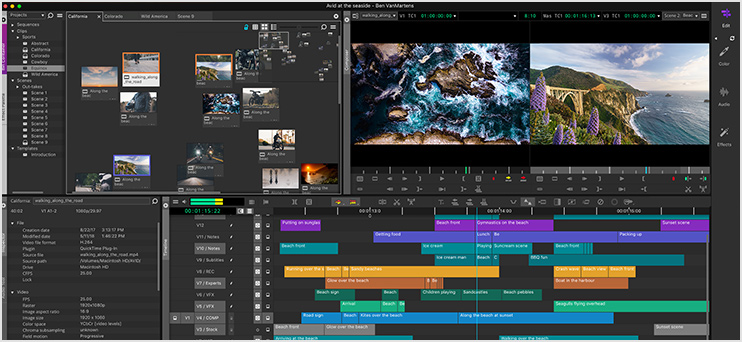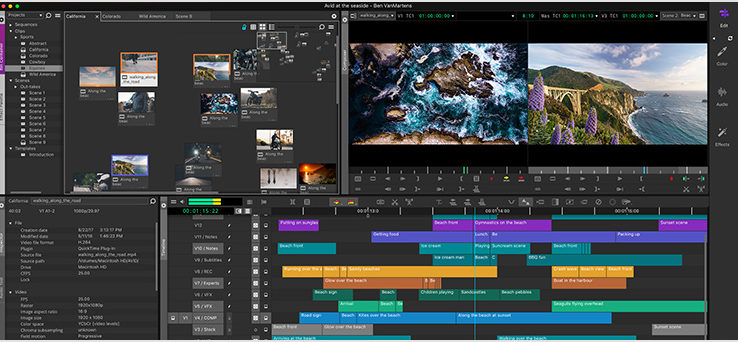Avid’s Media Composer Options Explained
By Adam Noyes
Once upon a time, choosing the right Avid licence was easy. There was one version of Media Composer. You ran it on the most powerful workstation you had, and worked wherever that workstation was. Now, things are slightly more complicated. Remote, virtualised and cloud options have brought fantastic functionality to Avid workflows, but left swathes of users unsure as to whether they’re using the right licence, and even if they have access to the full version of Media Composer. So we asked our experts: what’s the difference between the different Media Composer models?

The versions: First, standard and Ultimate
The first thing you need to know is that Media Composer now comes in three versions. Media Composer | First is a free version designed for students and hobbyists. It’s great for simple projects and for developing familiarity with the Avid ecosystem, but there are hard limits to the number of bins, tracks and formats you can support, and several professional features (LUTs, data tracks, effects tools) are missing or reduced.
Media Composer standard is the fully-fledged version of the software, with support for the full range of formats and tools. It’s exactly what you need if you’re a professional editor working alone.
Media Composer | Ultimate offers the same functionality as Media Composer standard, but adds collaborative tools designed to help larger editorial teams work more effectively. It’s also the version you’ll need if you want access to features like PhraseFind and ScriptSync, or the Media Composer Symphony option. New features are often rolled out to Ultimate users first, so if staying at the cutting edge of technology is important to your business, opt for Ultimate.
The new addition: Enterprise
At NAB 2019, Avid announced Media Composer | Enterprise, a tool that allows you to create customised, role-based interfaces for different members of your team. This customisation could be removing specific settings or menu options from within the application to help streamline the user’s experience. While it follows the same naming convention as full versions of Media Composer, it’s actually a software subscription.
The delivery methods: Cloud VM, Cloud Remote and Azure
As well as different licence types, Avid offer a number of different delivery models. You can buy a standalone licence and install it on your workstation or laptop like you always have, but you can also take advantage of a range of remote access options without losing any of the software’s functionality.
For example, purchasing a Media Composer | Cloud VM licence gives you the ability to run Media Composer on a virtual machine that your editors can then access using low-cost PCs, Macs or thin clients. The number of Cloud VM licences you have dictates how many virtual machines you can run at any one time – there’s no limit on where they’re accessed from, what kind of setup your editors have in their suites, or what they can do.
If you use Interplay | Production, you also have the option of using Media Composer | Cloud Remote. In this delivery model, editors still use a fully-featured version of Media Composer, but can work from a location away from their media, over a network connection, using a “bandwidth optimised” version of their media. Again, this is a fully-featured version of Media Composer, but this time you work with a lower res proxy version of your edit.
More recently, Avid have partnered with Microsoft Azure to deliver Media Composer from Azure. In this model, you pay for access to a virtual machine hosted by Avid in Azure with Avid storage. You download a PC over IP client (included as part of your licence) and you can then log into your virtual machine from any device on which the client is installed.
Working in this is exactly like working with a fully-featured version of Media Composer, except your user interface is delivered via PC over IP (PCoIP) protocol.
In all of these cases, the feature set of Media Composer remains consistent with the licence type you originally purchased, but the mechanics of each delivery method offer certain advantages and challenges that make them best suited to different scenarios.
Which delivery method should you choose?
It can be tempting to stick to the old one licence, one workstation, one location way of doing things, but frankly this method of working is becoming dated, and failing to change may affect your bottom line and your ability to attract top talent. So which delivery method is best for which scenario?
Media Composer | Cloud VM shines in large facilities where the central management of licences, software upgrades and licences is key to smooth day to day operations. You can replace in-suite workstations with simpler, cheaper PCs or Macs which editors and colourists use to access a virtual machine that relies on hardware hosted centrally in your MCR or a datacentre. This immediately reduces hardware spend and means that all your rooms are now multi-purpose, as you can simply point different users at different virtual machines depending on whether they’re working on the offline, online or grade of your footage.
Because all of your hardware is in a single location and all your licences are managed centrally by a system administrator, it’s fast and easy for engineering teams to push out or restrict updates, saving time and money and ensuring smooth day-to-day operations.
Cloud VM is not a “work anywhere” solution as it requires a professional quality network connection and has some technical caveats (you can’t use an SDI monitor, for example, and Avid don’t recommend it for footage over 30fps). But if you want to collaborate with key talent in other facilities – for example, you’re a regional facility working with creatives who can’t get out of London – Cloud VM is the easiest way for them to get access to your full resolution media and work with it in real time. And because any outside collaborator is access your virtual machines and shared storage, the media never leaves your storage and network, reducing the risk of data loss and leaks.
Media Composer | Cloud Remote is more of an all-purpose remote working tool, ideal for on-set editors, ENG crews and OB teams. Because you utilise use a fully-featured version of Media Composer, you have the full tool set available, which means media can also be uploaded from the remote locations back to the facility so that you can work collaboratively with colleagues at HQ.
Cloud Remote’s two key benefits are 1) that it uses intelligent bandwidth management to ensure that no matter how bad your connection is, you get seamless playback of your footage (even if it’s very low res) and 2) it has a comprehensive set of background syncing tools that make backing up footage to central storage easy and immediate. Reporters in the field can upload, download, transcode and back up clips in the background while editing. If they’re using a combination of clips on local and shared storage, Cloud Remote’s background sync feature will ensure that the necessary clips are in place for playback, wherever that happens.
However, because you’re always working with proxy footage, Cloud Remote isn’t suitable for grading or finishing work, or any scenario where it’s vital that you’re working with native resolution footage.
Media Composer Azure is new and part of Avid’s first move into the cloud. Usability has been impressive, particularly if your workflow already relies heavily on the cloud. For example, if a facility in London is collaborating with one in Amsterdam, sharing footage over a high-bandwidth connection to private cloud storage is probably the most efficient way to work. We have experience with using Media Composer Azure, and can advise on whether individual deployments will benefit from this technology – get in touch on the details below to find out more.
On premises virtualisation
Of course, using virtual machines to enable editing on low-cost endpoints to give remote workers access to footage isn’t a new idea, and has been going on for far longer than Avid have offered Cloud VM and Cloud Remote as options. It’s still possible to buy your individual licences of Media Composer, install them on hardware in your MCR, and then deliver those machines virtually.
For editors in your facility, we’d recommend going with a hardware virtualisation solution and using Amulet Hotkey’s PCoIPtoolkit. Well-established in the corporate and financial worlds, Amulet Hotkey have made real inroads into post-production environments thanks to the reliability and relative simplicity of their solutions. Essentially, you replace your workstations with thin clients and a keyboard, display and mouse, and whenever a user logs in, Amulet Hotkey will point the thin client at the correct virtual machine for their job, be that offline editing, online or finishing. All your suites become multi-purpose, and your end users can use whichever displays or controllers they prefer, meaning there’s no disruption to their day to day workflow.
For remote workers, try a software-driven solution like those from Teradici. The end user simply downloads a software client that allows them to log in to a virtual machine via their PCoIP software, meaning they can work on any hardware they like and from whichever location is most convenient for them.
Live demos
The best way to work out which option is for you is to see them in action. At our Soho demo facility, we have a range of Media Composer workflows set up, including remote connection to our Clerkenwell datacentre. We can demo each of these options in real time, as well as demoing various options for hardware virtualisation, colocation and cloud-first workflows. To arrange a demo or find out more, get in touch on the details below.

